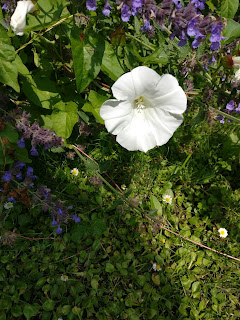At Swansea University Singleton campus, Hedge bindweed (Calystegia sepium); Enchanter's nightshade (Circaea lutetiana) and Monkey flower (Mimulus guttatus) were in bloom. On the beach opposite, Tutsan (Hypericum androsaemum); Lady's bedstraw (Galium verum); the hips of Burnet rose (Rosa pimpinelifolia); Stone bramble (Rubus saxatilis); Sea stock (Matthiola sinuata); Sea bindweed (Calystegia soldanella); Common broomrape (Orobanche minor) and Rest-harrow (Ononis repens) all made appearances.
This blog may help people explore some of the 'hidden' issues involved in certain media treatments of environmental and scientific issues. Using personal digital images, it's also intended to emphasise seasonal (and other) changes in natural history of the Swansea (South Wales) area. The material should help participants in field-based modules and people generally interested in the natural world. The views are wholly those of the author.
Wednesday, 21 June 2017
Seeing the Changes 1204
At Swansea University Singleton campus, Hedge bindweed (Calystegia sepium); Enchanter's nightshade (Circaea lutetiana) and Monkey flower (Mimulus guttatus) were in bloom. On the beach opposite, Tutsan (Hypericum androsaemum); Lady's bedstraw (Galium verum); the hips of Burnet rose (Rosa pimpinelifolia); Stone bramble (Rubus saxatilis); Sea stock (Matthiola sinuata); Sea bindweed (Calystegia soldanella); Common broomrape (Orobanche minor) and Rest-harrow (Ononis repens) all made appearances.
Subscribe to:
Post Comments (Atom)
-
I n the UK and US, a pparently popular and successful vegan/vegetarian restaurants are reportedly closing or adding meat to their menus ( ...
-
Early ripening fruit may seem convenient but some folk think it confirms environmental stress. There's also a possibility th...












%20mating%20NWCW.jpg)


No comments:
Post a Comment